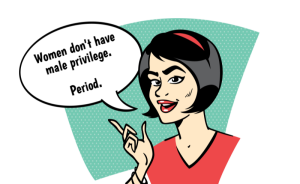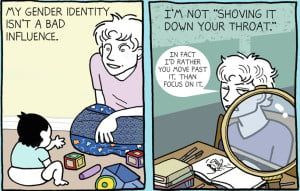
Person looking distraught with furrowed brow, one hand on their forehead, and the other hand on the side of their face
I was “too big for my britches.” I was “oversensitive.” I was “incompetent.”
These are a few ways I tried to explain away a supervisor bullying me at work for a year.
I repeated all of them to myself sobbing in a bathroom stall on my second-to-last day of work.
Minutes before sobbing in the bathroom stall, I had approached my supervisor, Samuel*, to explain an edit. He soon stood up from his desk, yelled “I can’t handle this anymore,” and slammed the office door.
I know, now, nothing I did justified that behavior.
The Workplace Bullying Institute describes workplace bullying as repeated mistreatment, verbal abuse, and other threatening, humiliating, intimidating, and sabotaging tactics that hurt someone’s health and their ability to work.
Bullying can take many forms. In my case, Samuel consistently tried to intimidate, undermine, shame, and ignore me.
I could feel Samuel standing behind my desk before I would see him. He’d gravely point out every mistake I made in the paper that week, which he marked in highlighter, and he’d CC our boss when I e-mailed him a question, saying, “I’ve told Emily this repeatedly.”
When I did something Samuel didn’t like, he’d sometimes yell or storm out of the room.
I panicked each morning when Samuel turned on the lights. I came home in tears nearly every day.
As a white, cisgender, bisexual woman born into a middle-class background, I can’t speak for everyone. However, I know I’m not the only one who’s discounted their own experiences of workplace bullying.
Unlike sexual harassment, workplace bullying isn’t necessarily illegal.
It’s easy to dismiss as “not that bad” – especially when society has socialized us to discount our own experiences.
Yet, as many as 75% of US workers either witness or experience bullying. While bullies target all demographics, those who suffer the most tend to be marginalized in other ways as well.
A study, which didn’t account for non-binary folks, found that most targets are women and most perpetrators are men. Furthermore, intersecting identities related to race, class, gender identity, sexual orientation, and disability can make it even more likely that bullying affects someone.
For one example, Latinx workers are the most likely to experience or witness workplace bullying. Also, 90% of transgender workers report mistreatment and harassment on the job, according to the Williams Institute.
While there haven’t been too many studies in the US on the subject, UK research found that disabled employees are more likely than their able-bodied counterparts to get bullied as well.
The reality can be suffocating, especially if you want to keep your job. Our culture hasn’t learned to take workplace bullying seriously yet. Our governments don’t. Our workplaces don’t.
Society enables bullying so much that over 80% of people targeted lose their jobs, compared to fewer than 20% of perpetrators.
Here are some tools to help you confront workplace bullying without sacrificing self-care.
1. Believe Yourself
Sometimes it’s easy to doubt your own experiences getting bullied, particularly if you’re already silenced and marginalized.
After all, our society teaches women and femme-identifying people in particular to discount their own life experiences and cede to authority, which often takes the form of cisgender men.
This is part of a long-term tradition of heteropatriarchy, where femininity is consistently undervalued to uphold a masculine, normative power system.
We need to realize workplace bullying is another form of abuse.
Our society likes to blame victims for their perpetrators’ behavior. Targets of bullying can fall into that trap, too, internalizing assumptions that if they did or didn’t do something, the abuse wouldn’t happen.
Common narratives around workplace bullying say that perpetrators target people who are more skilled, kind, or well-liked than them.
However, these false justifications imply that the bullied person did something to provoke the bully. Targets never invite their coworkers or supervisors’ third degree.
Still not sure you’re getting bullied? Check your health.
Clinical psychologist Ruth Namie says emerging issues including high blood pressure, sleep troubles, and stomach problems can indicate bullying.
Also, consider asking those close to you if they’re noticing anything off about you. Your loved ones might be able to notice symptoms of bullying, like changes in your overall mood and behavior.
2. Document Everything
Society often teaches us that women and femmes aren’t to be trusted. At every turn, we hear our concerns aren’t valid or that we’re exaggerating or even lying.
With workplace bullying, bullies may compile a false record against you. Perhaps they’ll try to make you look difficult to work with to justify their behavior.
Never mind that there’s absolutely no excuse for abuse. You can fight their narrative with evidence that says otherwise.
Consider keeping a record of every toxic e-mail, conversation, and incident that happens at work.
Take down concrete details like dates, times, locations, behaviors, and witnesses, as well as what was said and how it was said. “Facts, not feelings, tend to sway employers,” says Gary Namie of the Workplace Bullying Institute.
Keep in mind you can also legally record a conversation between you and your bully discreetly in many states.
A solid body of evidence should work in your favor, whether you choose to report within your organization or after you leave.
In my case, the business gave me two options after I complained: I could either sustain a drastic cut to my hours (from full-time to fifteen hours per week) or quit altogether. They chalked the problem up to a “personality conflict” and said I should’ve kept records since the beginning.
I don’t know if keeping records would’ve helped get my employers on my side. Samuel had much more power in the organization. And as a more experienced worker, he was harder to replace than me.
But at the very least, record-keeping reminds us that we aren’t imagining what’s happening.
3. Educate Yourself
Bullies deliberately try to make you feel helpless. And most likely, your options are limited.
After all, the US is the last remaining Western democracy to lack a federal law against workplace bullying, according to the Healthy Workplace Campaign. On top of that, very few US employers have stepped in with their own policies to protect their workers.
However, you still may have laws or policies that may protect you.
Are you part of a union? Consider contacting them. What are your employer’s policies? How about your state?
Are there any anti-discrimination laws that apply? After all, the Workplace Bullying Institute says discrimination has a part in a quarter of bullying cases. (Here’s a primer on workplace discrimination.)
Ruth Namie recommends talking to a lawyer for an hour to see if there’s anything you can do.
For those who can’t afford a lawyer, you may be able to get free legal advice from a legal association in your area at a monthly legal night. The American Bar Association has a handy map to help you contact groups in your area.
Bully Online has additional resources for those being bullied in the US.
We need to stop believing in a “suck-it-up” professional culture, where we’re expected to keep our heads down and work hard and everything will be better.
Our psychological well-being doesn’t take a vacation just because we’re working. And it shouldn’t, especially if what we’re going through is against policy or illegal.
Going to work shouldn’t be a matter of survival. We shouldn’t have to conform to toxic upper-middle-class white masculine ideals of professionalism simply to make it.
4. Talk to Your Coworkers
A few months before my job ended, I went skiing with a few coworkers.
They mentioned something on the lift about Samuel being difficult, and I teared up. The whole time I thought no one saw anything happening.
For the first time, I mentioned how badly Samuel treated me to the people I worked with. I’d assumed that if I told anyone before, they’d just tell him.
I’d been quiet and slow to make friends at work, and Samuel seemed so well-liked.
Bullies flourish when their targets are isolated. They thrive with the stigma that keeps people from sharing their common experiences. According to Namie, “nearly half of coworkers will side with the bully to survive.”
Because not everyone will be an ally, keep in mind that reaching out publicly on social media may backfire.
In my case, I once posted jokingly about how I didn’t like my job on Facebook. One of my coworkers took a screenshot and sent it to my editor. If you are introverted or awkward in person, messaging one-on-one with someone you trust may be more effective.
At the same time, talking to your coworkers might help you neutralize a bully.
At the end of an episode, think about asking your coworkers if the bullying happens to them as well. Chances are, you aren’t the only one suffering.
We draw power from groups. Speaking up has a stigma that we can break if we talk to each other. We all deserve to feel safe at work – physically and psychologically.
5. Be Careful If You Choose to Confront the Bully
If you feel safe doing so, setting boundaries with your bully is worth a try.
“Be direct about what you do not like about his behavior and let him know that if he continues you will report him,” bullying expert Sherri Gordon tells Forbes. “Try not to get emotional when you are talking to a bully because he will likely use this against you.”
Also, there’s no shame if the conversation doesn’t go as planned. If you do get emotional, or you don’t feel safe confronting your bully, your experience is still valid.
“Nearly 70% of targets confront their perpetrators,” says Namie, but they often do it months later.
Employers often treat targets of bullying like they’re randomly lashing out, especially in a culture that rewards bullying. In turn, the target may feel humiliation and guilt that they didn’t protect themselves or react properly.
Never mind there isn’t a way to “react properly” to abusive behavior. And targets shouldn’t be expected to behave when their bullies are the ones behaving badly.
Sadly, tone-policing is prevalent in workplaces – pressuring targets to take a “kinder” tone than actual bullies, who tend to hold more power. You may also face retribution for speaking out.
Make sure you watch out for yourself first, whether you choose to confront the bully or not. The onus for stopping abusive behavior is always on the perpetrator – getting them to stop is not your obligation. In fact, in a better world, bystanders would help do that for you.
Also, it’s always okay to skip this step or walk away from an interaction if you feel uncomfortable or unsafe.
6. Report It
To improve your working conditions, you may need your employer to step in.
However, keep in mind that reporting may backfire, especially if the bully is a supervisor.
Make sure you do your homework before: Research your options, gather your records, and maybe even do an analysis of what bullying costs the company.
You have several options:
- Report to your supervisor (or the person above them, if your supervisor’s the bully).
- Report to Human Resources (if you have a formal HR Department).
- Report to the highest-ranking boss you can reach.
For what it’s worth, Namie warns that “bullies typically retaliate with complaints to Human Resources.” He says, “It’s better to see an attorney [and have them] write your employer a letter from the outside demanding to be treated fairly.”
Understand that legal threats or actions will probably get you pulverized if you’re still working there. The business may treat you like the troublemaker, even if you’re right. You may even get fired, especially if you live in an at-will state.
We live in a culture that hasn’t overcame the stigma of being a “tattle-tale.” This is a powerful form of victim-blaming – where employers demonize the people who report, rather than the bullies themselves.
We can gradually chip away at those attitudes every time we report and demand accountability.
At the same time, these obstacles in reporting mean that everyone will not feel safe speaking up, and that makes sense, too. Do what you think is right for you.
7. Care for Yourself
Confronting workplace bullying starts and ends with self-care. Self-care looks different for everyone, but here are some options that might be available:
- If you can afford some time off to gather your thoughts, please do so. See a doctor. If it helps, see a therapist. Check your mental and physical health.
- Spend time with people who care about you. Hopefully, this includes yourself.
- Schedule time for hobbies.
- Brainstorm ways to cheer yourself up at work. Former target Sherry Benson-Podolchuck plastered her desk with positive messages on sticky notes for encouragement.
- Start looking for another job. For many of us, finding another job may not be easy, but if it’s an option for you, believe that you deserve a safer workplace. If applicable, organizations like the California Trans Workplace Project, Enable America, and the Higher Education Recruitment Consortium may help.
Bullying whittles away your self-worth. Self-care helps counter it. Don’t be afraid to reach out to those close to you for help.
***
Workplace bullying is daunting. But you can fight it.
If coworkers or supervisors are bullying you, remember, you aren’t alone. At least 37 million others out there have also been targeted.
For additional resources, visit the Workplace Bullying Institute’s website.
[do_widget id=’text-101′]
Emily Zak is a Contributing Writer at Everyday Feminism and a freelance writer based out of Santa Fe, New Mexico. She writes extensively on LGBTQIA+ issues, and her work has appeared on Ms. Online, Bitch Media and Care2, among others. Follow Emily on Twitter @EmilyEZak. Read her articles here.
Search our 3000+ articles!
Read our articles about:
Our online racial justice training
Used by hundreds of universities, non-profits, and businesses.
Click to learn more
Most Read Articles
- « Previous
- 1
- …
- 30
- 31
- 32



















